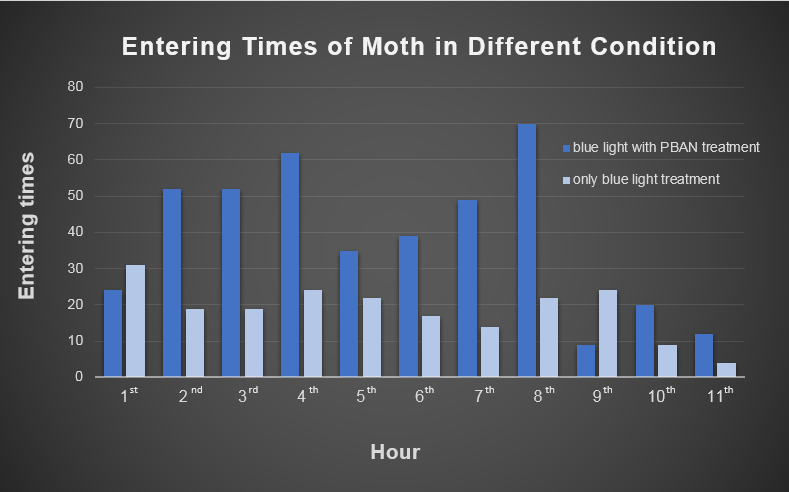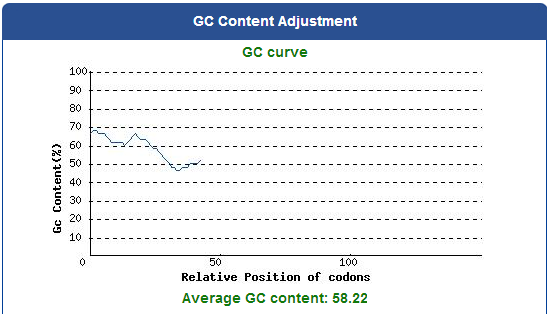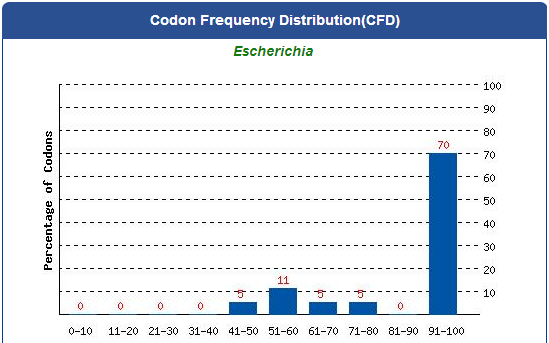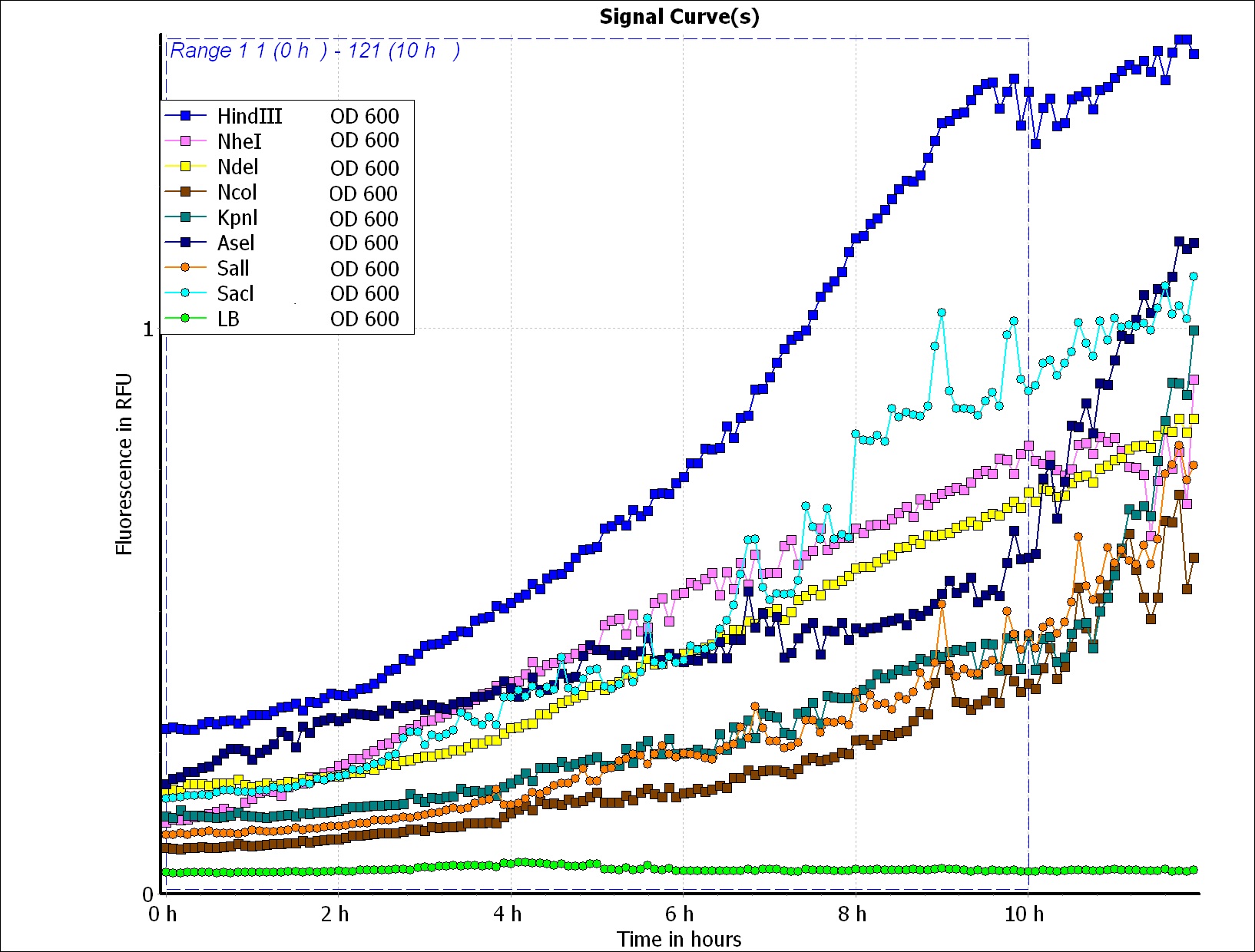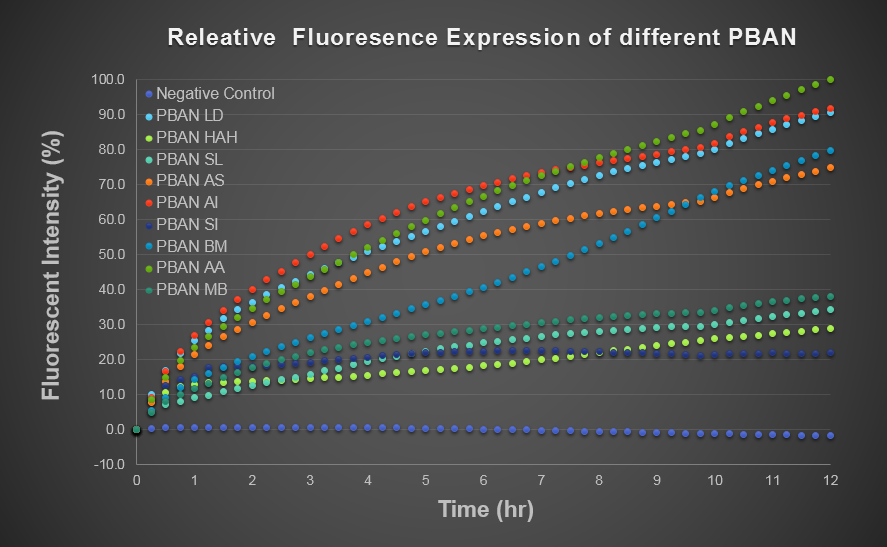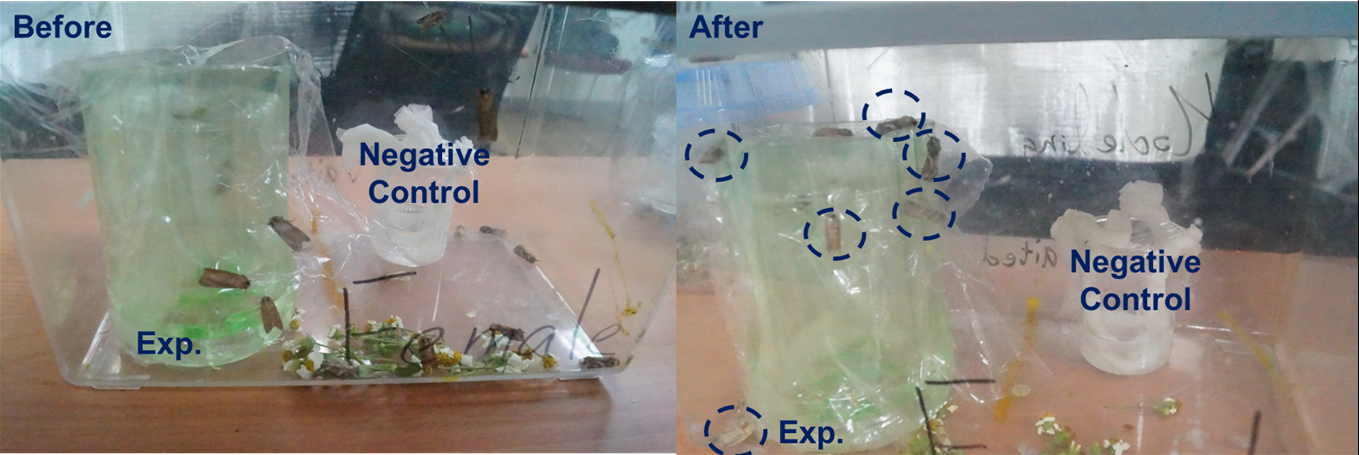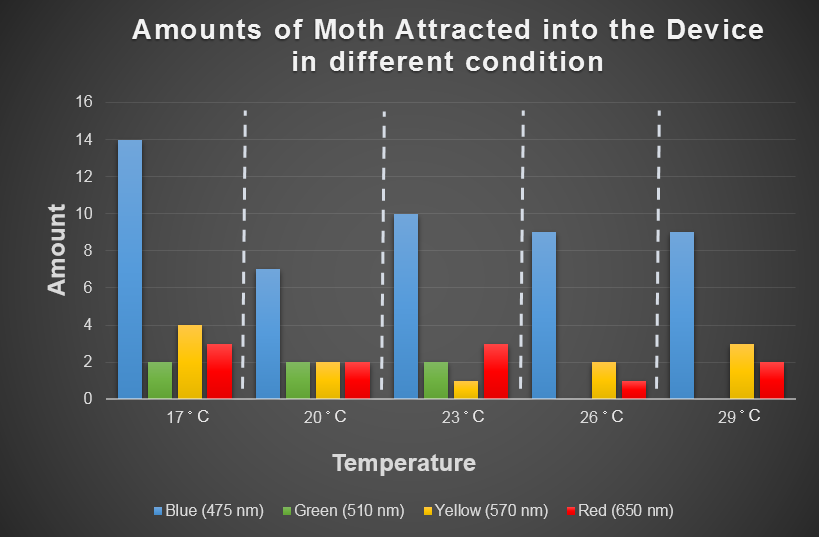Team:NCTU Formosa/results
From 2014.igem.org
Contents |
Magic Power of Our Pyramidal Device
Our device combines blue light and PBAN to achieve a powerful and specific insect attraction. We did a long-time observation to record the entering number (into our pyramidal device) per hour below. In Fig.2-0, we can really see the magic power of attracting insects in our device!
Our experiment can divided into two categories.
1. About PBAN Biobricks Test: gene recombination and protein expression.
2. About Insect Tests: PBAN effect test, insects' habbit test and our device test.
PBAN Biobricks Test
PBAN Gene Synthesis (Full Gene Sequence Design Process)
To capture harmful insects causing lots of damage in agriculture, we first found 9 different kinds of PBAN peptide of common harmful insects all over the world from many references. Next, we got the DNA sequence of these PBANs in NCBI (EX: PBAN Spodoptera litura:http://www.ncbi.nlm.nih.gov/protein/AAK84160.1 ) Finally, we modified every codon on the DNA sequence and designed the DNA sequence for E.coli to express a certain PBAN.
DNA Modification Process:
1. Avoid the rare codon of E.coli, and choosing high frequency codons.
( Frequence Table Tool:http://www.genscript.com/cgi-bin/tools/codon_freq_table )
2. Avoid choosing the same codon when modified our designed gene sequence to prevent the E.coli using up the limited nucleotides.
3. Avoid the start codon ATG existing in the front of our DNA sequence.
4. Use Rare Codon Analysis Tool ( http://www.genscript.com/cgi-bin/tools/rare_codon_analysis ) to inspect if there is any problem to express our gene for E.coli.
Take the PBAN of Spodoptera litura for example:
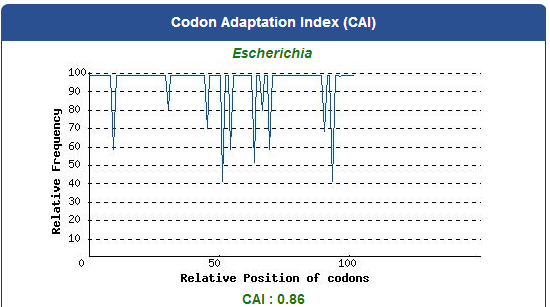
5. Add iGEM standard sequence in front of and at the back of our modified DNA sequence.
6. Synthesize the modified DNA sequence of PBANs in a gene synthesis company.
PCR experiment of PBAN

For checking the size of the DNA sequence received from the gene synthesis company, we recombined each PBAN gene to PSB1C3 backbone and conducted a PCR experiment for checking each size of PBAN.
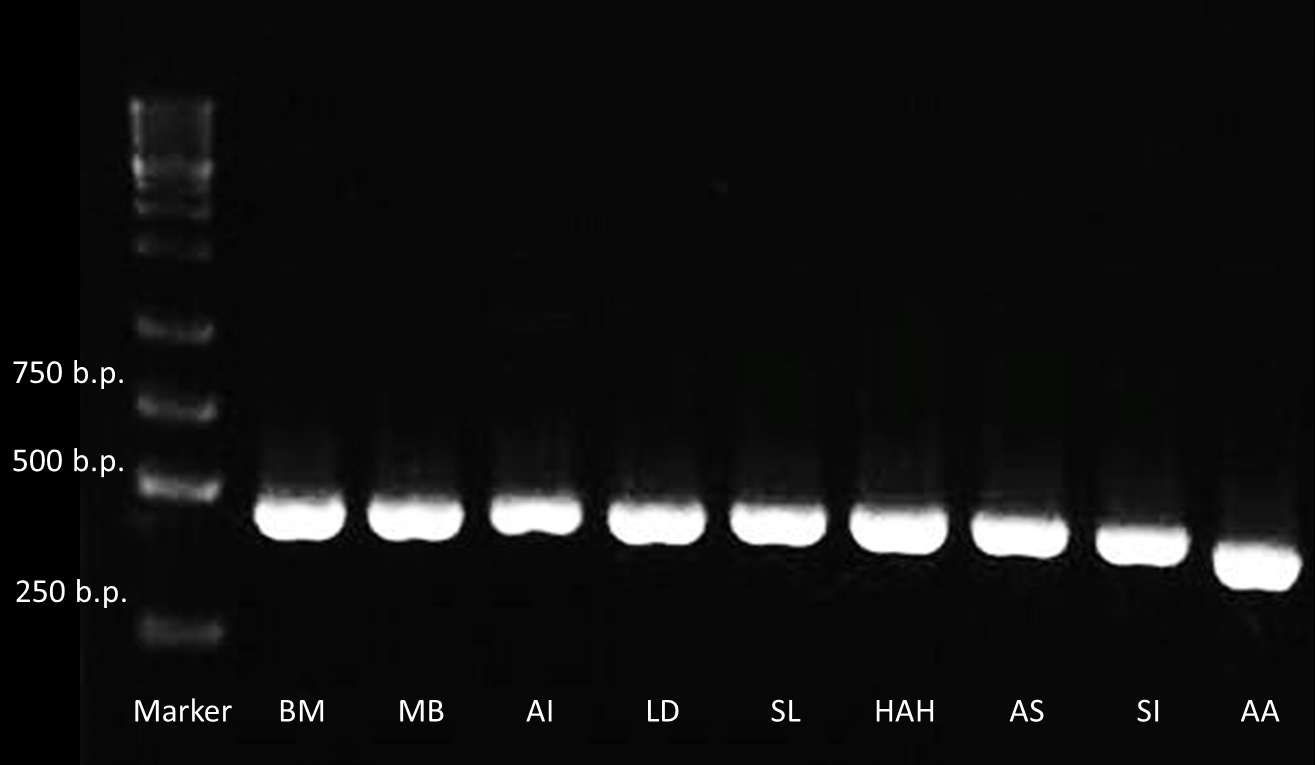
Below are biobrick serial numbers of PBAN abbrevation:
BM: BBa_K1415001 MB: BBa_K1415002 AI: BBa_K1415003 LD: BBa_K1415004 SL: BBa_K1415005 HAH:BBa_K1415006 AS: BBa_K1415007 SI: BBa_K1415008 AA: BBa_K1415009The DNA sequence length of the PBAN are around 100~150 bp. In this PCR experiment, the PBAN products size should be near at 415~515 bp. The Fig.2-1-3 showd the correct size of the PBAN, and proved that we successful ligated the PBAN DNA sequence onto an ideal backbone.
PBAN Peptide Check by SDS Protein Electrophoresis

Moreover, for checking all the 9 kinds of PBAN can be produced by the E.coli, we conduct a SDS protein electrophoresis experiment. We first smashed the E.coli containing the PBAN with a solicitor and then took the supernatant divided from the bacterial pellet by centrifugation. Finally, we used the supernatant to run a SDS protein electrophoresis in a 20 % SDS gel.

Below are biobrick serial numbers of PBAN abbrevation:
BM: BBa_K1415001 AA: BBa_K1415009 LD: BBa_K1415104 AS: BBa_K1415007 SL: BBa_K1415005
Below are biobrick serial numbers of PBAN abbrevation:
AI: BBa_K1415003 MB: BBa_K1415002 HAH:BBa_K1415006 SI: BBa_K1415008These SDS PAGE results in Fig.2-1-6 showed that the band at 2~4 kDa of each PBAN, while the plasmid of Pcons+RBS wasn't appeared (the PBAN peptide is an around 30 amino acids substance). This result proves that the E.coli can produce the PBAN we chosen.
Blue Light Fluorescence / Bacteria Growth Test

To predict the PBAN expression in E.coli by computer modeling, we next tested PBAN biobricks along with blue fluorescence protein. We tend to estimate the average expressive value of the blue fluorescence in the biobrick part (above) and also the control part of Pcons + RBS + BFP + Ter. Therefore, we can use the average value as the prediction of the PBAN expression in E.coli. (See more details in our Modeling Page). This is the blue fluorescence expression curve and bacterial growth curve (OD 600) below in long time, we use these data to predict our PBAN expression in E.coli.
In Fig.2-1-5, we can clearly see the blue fluorescence expression by the E.coli different from the control without BFP inserted.

Process to Get PBAN from E.coli
For getting PBAN from our E.coli, we first cultivated the E.coli containing a plasmid composited of Pcons + RBS + One Kind of PBAN for 12 hr. Then, we smashed the E.coli with sonicator and centrifuged the solution to let the PBAN divided into the supernatant. Finally, we take the supernatant diluted by 1 liter pure water for autoclaving to avoid biosafety problems. As we know that PBAN is a very simple and short peptide, we suppose that it will not be degraded after the autoclaved treatment. This is all the process that we get PBAN from the E.coli.</p>
Insect Tests
Behavior of Target Insects After PBAN Treatment
To realize what kind of behaviors that female moth would show after releasing pheromone by eating PBAN, we put one or several female moths into a beaker which was divided into two layers. The lower layer contained the PBAN solution made by ourselves. Then we sealed the beaker with handi-wrap, the toilet paper which was soaked with PBAN solution connected the both layers of the beaker helping female moth to suck the PBAN solution. At the time, we started filming as soon as we observed that the female moth show obvious behaviors such as flapping their wings. In this observation, the sample of moth including Spodoptera litura, Mamestra brassicae and Helicoverpa armigera Hubner were caught in Sunny Morning organic farm.
We observed that as long as the target female moth ate the PBAN, tons of PBAN can be absorbed in the moth's body in high posibility and thus, the PBAN could stimulate the moth's pheromone gland to produce pheromone and made the moth rut. As soon as the moth rutted, it would flap its wings rapidly and move its tail upward slightly.
These movie show the behavior of two different kinds of female moths after eating the PBAN SL and PBAN MB. These two moths definitely expressed an exciting status and all flapped their wings rapidly.
Powerful Effect of PBAN
After observing the behaviors female moth showed, we conducted this experiment in the moth box to check the attractive effect of our idea. We hope that the female moth can not only become excited, flap its wings but also actually attract male moths to aggregate together after eating the PBAN. We used two beakers which are the same as what we used in the former experiment. One contained PBAN solution and the other contained only sucrose solution as control be put at two sides of the moth box. This time, we did a long time observation and took a picture with our camera. In Fig.2-3-1, the female moth ate the PBAN then attracted more male moths than the one without eating our PBAN. Thus, Fig.2-3-1 can prove the fact that the female moth ate our PBAN then releasing much sex pheromone to attract many male moths. In addition, we also conducted a simple test to compare our female moths eaing our PBAN with the sucrose solution (the moth favorite food) luring factor. Also, we can see the gigantic PBAN effect again.
Spodoptera Litura Hobby for Temperature and Light
Light can be probable of attracting target harmful female insects.
Temperature is the environmental factor which the farmer can not change practically. We want to use the computer modeling to deeply explore the relationship among light, temperature and the moths' hobby. In the future, we hope that farmers can choose the appropriate light according to temperature condition and even the kind of moths when using our device. For this, we choose the average temperature range in Taiwan in a year, and most common harmful insects, Spodoptera Litura to conduct this test (Fig.2-3-3 below), which we want to use to model the relationship among light, temperature and the moths' hobby with ANFIS (See detail in the device modeling page).
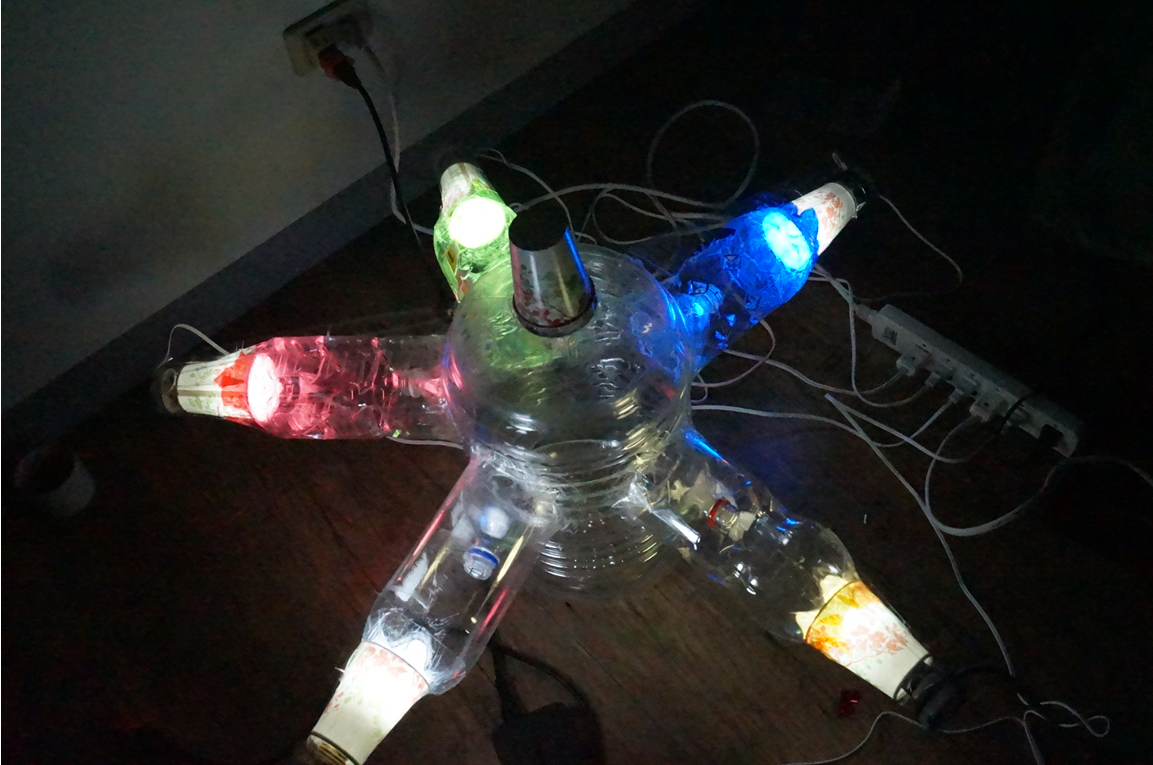
Fig.2-3-3 shows blue light have steady attraction to our target harmful moths, Spodoptera Litura, in any temperature condition. Thus, we decided to use blue LED light into our device design.
 "
"
